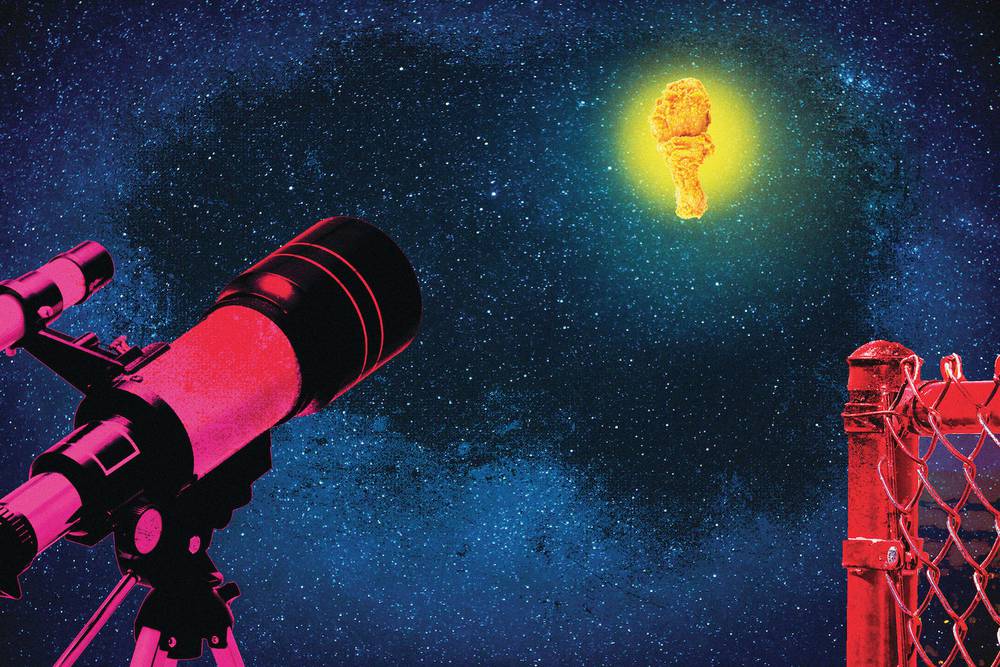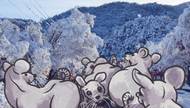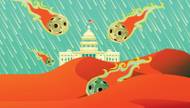After overhearing Fox News for an hour one afternoon in an office waiting room, I wanted reassurance that humankind matters very little in the cosmic scheme of things. We can be splendid creatures, but cable news argues vehemently to the contrary, and listening to back-to-back stories of terrorism and political jackassery made me long for evidence of other worlds.
I might have accomplished some peace of mind by looking up at countless twinkly stars in the night sky—one of our greatest psycho-spiritual recalibration tools—but locally, we traded that deep, dark, endless night for neon—and I have no beef with that. I’m a fan of Las Vegas’ brilliance.
So I decided to take my girlfriend to the planetarium at the College of Southern Nevada. I was so desperate for some cosmic perspective that the irony of seeking the natural universe in an enclosed, dome-shaped theater didn’t outweigh my need to try.
We arrived early at the Cheyenne campus, so we checked out some exhibits in the hallway: framed, signed pictures of astronauts, a NASA flight suit, some Nevada rock samples, a small octopus body and a replica T. Rex tooth. After a quick stop in the gift shop, where I bought a plastic egg containing a rubber baby alien, we made our way into the small theater and sat down with a host of others. A matter-of-fact man named Bob welcomed us and told us to sit back and enjoy the show. It felt beautifully old-fashioned.
I was earnestly excited by the apparent banality of the first show’s topic: ice. And I was ecstatic about the theme of the second show: black holes, into which I sometimes suspect I misstepped ice ages ago.
*****
Here are 10 phrases I wrote down while watching “Black Holes” in the packed planetarium, while the man behind me stealthily tried to eat fried chicken, which cannot be eaten stealthily and which is not allowed in the theater:
How a star dies. Seething maelstrom. White dwarf. Core of a collapsed star. Distortion in the fabric of spacetime. So massive it can’t escape its own light. Light bends. An uncontrolled and spectacular death dance. Medieval torture rack. Spaghettification.
Upon rereading these notes later, I had no idea how to explain the physics of black holes. It felt as if I had scribbled a drunken political poem, an abstract epitaph for our times. Still, the film was fascinating, and I was successfully transported millions of miles away, joyously contemplating the ferocious forces of the universe that could stretch us into spaghetti and then make us disappear. And I was duly impressed by the minds who’ve figured out small fragments of the wonder.
*****
Even though I still knew my reality, when I stepped out into the parking lot, looked up and saw only two stars, along with bright lights on a red and white circus tent being set up in the park next door, I felt the weight of re-entry.
Sometimes, though, it’s not the ambivalent universe but other humans who can deliver us. Bob politely rallied the post-show group over to CSN’s telescopes, which are behind a fence next to a parking lot on the corner of the campus. We were a fairly quiet bunch—families with kids, date-night couples, a well-fed chicken-eater and astronomy students, up here on a Friday night thinking about the solar system. While we waited in line to see Jupiter, I fell a little in love with the little crowd, the little planetarium, the little gift shop, our little spot in the grand scheme of things and the efficient man running the show. It was a cool, calm night, and Bob went into a domed observatory through a tiny door he had to hunch to get through. The hut began to whir and the domed top rotated and a window opened so that the telescope could take aim at the sky. People took pictures of the modest observatory, and whispered about massive black holes and waited patiently, and the whole thing felt mystical.
After Bob had Jupiter in focus, he invited us in two at a time, scrunched down, anti-spaghettified, macaroni-ified, to take a look. When it was our turn, I ducked into the dark space and looked into the eyepiece, and there it was, 416 million miles away—Jupiter, the biggest planet in our solar system, a tiny bright light pointed out by our Friday night science tour guide. I stared at it for a few long, quiet seconds. Its simplicity brought me peace.






